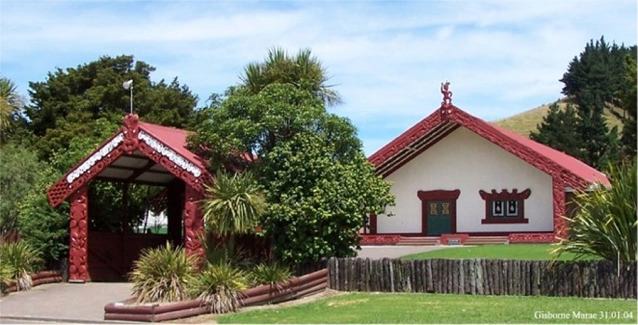Te Poho-o-Rawiri Maori
Marae - Gisborne New Zealand
Photo Gallery Categories
Home > NZ Photographs > Gisborne > Te Poho-o-Rawiri Marae
Te Poho-o-Rawiri (The Chest of David) Maori Marae situated in Gisborne New Zealand in the suburb of Kaiti Gisborne.
A marae (in New Zealand Māori, Cook Islands Māori, Tahitian), malaʻe (in Tongan), meʻae (in Marquesan) or malae (in Samoan) is a communal or sacred place that serves religious and social purposes in Polynesian societies. In all these languages, the term also means cleared, free of weeds, trees. Marae generally consist of an area of cleared land roughly rectangular (the marae itself), bordered with stones or wooden posts (called au in Tahitian and Cook Islands Māori) perhaps with paepae (terraces) which were traditionally used for ceremonial purposes; and in some cases, a central stone ahu or a'u. In the Rapa Nui culture of Easter Island, the term ahu has become a synonym for the whole marae complex.
In some modern Polynesian societies, notably that of the Māori of Aotearoa New Zealand, the marae is still a vital part of everyday life. In tropical Polynesia, most marae were destroyed or abandoned with the arrival of Christianity in the 19th century, and some have become an attraction for tourists or archaeologists. Nevertheless, the place where these marae were built are still considered tapu (sacred) in most of these cultures.

These photos are copyright protected. They may not be copied or used without our express permission.
A wharenui ([ˈfaɾɛnʉ.i] literally "big house") is a communal house of the Māori people of New Zealand, generally situated as the focal point of a marae. Wharenui are usually called meeting houses in New Zealand English, or simply called whare (a more generic term simply referring to a house or building). Also called a whare rūnanga ("meeting house") or whare whakairo (literally "carved house"), the present style of wharenui originated in the early to middle nineteenth century. The houses are often carved inside and out with stylized images of the iwi's (or tribe's) ancestors, with the style used for the carvings varying from tribe to tribe. Modern meeting houses are built to regular building standards. Photographs of recent ancestors may be used as well as carvings. The houses always have names, sometimes the name of a famous ancestor or sometimes a figure from Māori mythology. Some meeting houses are built where many Māori are present, even though it is not the location of a tribe; typically, a school or tertiary institution with many Māori students.
While a meeting house is considered sacred, it is not a church or house of worship, but religious rituals may take place in front of or inside a meeting house. On most marae, no food may be taken into the meeting house.
Structure
The building often symbolises an ancestor of the wharenui's tribe. So different parts of the building refer to body parts of that ancestor:
- The koruru at the point of the gable on the front of the wharenui can represent the ancestor's head
- The maihi (the diagonal bargeboards) signify arms; the ends of the maihi are called raparapa, meaning "fingers"
- The tāhuhu (ridge beam) represents the backbone
- The heke or rafters signify ribs
- Internally, the poutokomanawa (central column) can be interpreted as the heart
Other important components of the wharenui include:
- The amo, the vertical supports that hold up the ends of the maihi
- The poupou, or wall carving underneath the verandah
- The kūwaha or front door, along with the pare or door lintel
- The paepae, the horizontal element on the ground at the front of the wharenui, acts as the threshold of the building
- The marae ātea comprises a very important open space directly in front of the wharenui, and is used to welcome visitors onto the marae. It also serves as an area on which to debate issues.
Protocols
Meeting houses are the centre of any cultural, business, or any affair which is relevant to the iwi as a whole.
- Typically, visitors to the village would be allowed to stay in the meeting house at night.
- Ceremonial occasions, including wedding and funeral typically take place in the meeting house or on the marae ātea in front of the house.
- Strict rules of conduct generally govern the use of the wharenui, which is considered the domain of unity and peace. If anyone should become irate or physically violent, they would be asked to leave the house until they can control their temper.


